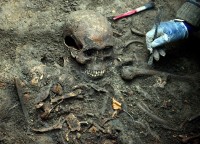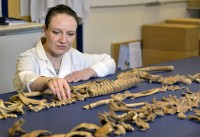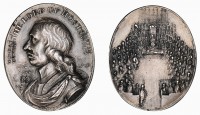 In November of 2013, construction crews building a new coffee shop for Durham University’s Palace Green Library came across human skeletal remains. Construction was halted immediately and an archaeological excavation ensued. Under an internal courtyard at the south end of the site, archaeologists unearthed a jumble of bones, the remains of more than a dozen people who had been buried in two pits. The mass graves extend north, south and east past the excavated area under buildings and walls and only the area directly impacted by construction was excavated so there are likely many more human remains still underground. The bones in the path of construction were removed for study before reburial.
In November of 2013, construction crews building a new coffee shop for Durham University’s Palace Green Library came across human skeletal remains. Construction was halted immediately and an archaeological excavation ensued. Under an internal courtyard at the south end of the site, archaeologists unearthed a jumble of bones, the remains of more than a dozen people who had been buried in two pits. The mass graves extend north, south and east past the excavated area under buildings and walls and only the area directly impacted by construction was excavated so there are likely many more human remains still underground. The bones in the path of construction were removed for study before reburial.
University researchers found that there were at least 17 individuals and as many as 29 buried in the pits. Because they had been buried with little care, the skeletons were disarticulated and it wasn’t possible to identify the exact number. Most of them ranged in age from 13 to 25 with a few older individuals. All the adults were male and the adolescents probably were as well but their sex could not be conclusively determined. The sex and age indicate these individuals were soldiers. If they had been general population struck by plague, say, there would have been a representative proportion of men, women, children and elderly. (They also probably wouldn’t have been buried in the city center on the castle grounds.)
 Stable isotope analysis from tooth enamel revealed that six of the deceased were likely from Scotland, four from Scotland or Northern England, one more likely to be Scottish than English and three who were not from the British Isles. They grew up further east, in a cooler climate or a higher altitude; they may have been German or Dutch. Two of the men had crescent-shaped notches in the teeth called “pipe facets” caused by habitual biting on the stems of clay pipes.
Stable isotope analysis from tooth enamel revealed that six of the deceased were likely from Scotland, four from Scotland or Northern England, one more likely to be Scottish than English and three who were not from the British Isles. They grew up further east, in a cooler climate or a higher altitude; they may have been German or Dutch. Two of the men had crescent-shaped notches in the teeth called “pipe facets” caused by habitual biting on the stems of clay pipes.
That’s a key date marker because clay pipe smoking became popular in Britain in the early 17th century, so the bodies can’t have been buried before 1620. A building was constructed over some of the mass grave in 1754 which narrows the date further. Radiocarbon testing dates the remains to 1625-1660. That range is mighty suggestive. There was a civil war going on in Britain in the middle of those dates, after all.
Durham University experts believe all the evidence points to the men buried in these mass graves being soldiers in the Scottish army who were on the losing side of the Battle of Dunbar, fought on the southeast coast of Scotland exactly 365 years ago today on September 3rd, 1650. It was a short but brutal fight in which Oliver Cromwell’s Parliamentarian army crushed the Royalist Scottish Covenanter army in less than an hour. According to contemporary sources, up to 5,000 men lost their lives on the battlefield. Modern historians estimate that 4,000 Scottish soldiers were captured by Cromwell and marched through Newcastle upon Tyne 100 miles south to Durham. Approximately 1,000 of them died on the way, mainly from starvation, exhausting and dysentery.
 When the 3,000 or so survivors reached Durham, they were imprisoned in Durham Cathedral which at the time was no longer functioning as a church since Cromwell had kicked out the Dean and Chapter. Conditions were appalling. It was cold and there was little food or water to be had. The Scottish prisoners stripped the cathedral’s wood to burn for heat, sparing only Prior Castell’s Clock out of deference for the Scottish thistle carved on it. (That’s the romantic story. The more practical version is that the clock was dismantled and removed when the cathedral was converted into a prison.) An estimate 1,700 of the prisoners died in captivity.
When the 3,000 or so survivors reached Durham, they were imprisoned in Durham Cathedral which at the time was no longer functioning as a church since Cromwell had kicked out the Dean and Chapter. Conditions were appalling. It was cold and there was little food or water to be had. The Scottish prisoners stripped the cathedral’s wood to burn for heat, sparing only Prior Castell’s Clock out of deference for the Scottish thistle carved on it. (That’s the romantic story. The more practical version is that the clock was dismantled and removed when the cathedral was converted into a prison.) An estimate 1,700 of the prisoners died in captivity.
As for the survivors, some of them were forced to work in salt and coal mines in northeast England or to drain the Fens in Norfolk. About 500 were conscripted to fight in the Parliamentarian army in Ireland. Others were sold as indentured servants to the tobacco plantations of Virginia and the sugar plantations of the Caribbean. About 150 of them were sent to New England where they were sold as indentured servants to sawmills and ironworks for £20 a head. The term of indenture was limited and if they raised sufficient funds they could buy themselves free before the term was up.
There is no evidence of cause of death in the bones exhumed from the mass grave, nor are there extensive healed wounds or perimortem wounds as you might expect to find on soldiers’ remains. Counterintuitively, that supports a Dunbar connection because the Scottish soldiers who fought there are known to have been largely inexperienced fighters and the ones who suffered severe injuries either died on the field or were released back to their side right after battle. Only the soldiers who had made it out of the fight relatively intact were taken prisoner and marched down south where they eventually died of starvation or disease.
The presence of non-Scots is also in keeping with what we know about the Scottish army. Contemporary sources note the presence of Dutch and German soldiers in the Scottish army just weeks after the Battle of Dunbar. It seems likely they were at the battle too.
Richard Annis, senior archaeologist at Archaeological Services Durham University, said: “This is an extremely significant find, particularly because it sheds new light on a 365-year old mystery of what happened to the bodies of the soldiers who died.
“Their burial was a military operation. The bodies were tipped into two pits, possibly over a period of days. They were at the far end of what would have been the Durham Castle grounds, as far as possible from the castle itself – they were out of sight, out of mind.
“It is quite possible that there are more mass graves under what are now university buildings that would have been open ground in the early to mid-17th Century.”
The remains will be reinterred as required by the terms of the exhumation license. Durham University and Durham Cathedral are working together with other interested parties (the Church of Scotland, for instance) to determine the most respectful approach. Certainly burial in the cathedral is out given that most of the dead were probably Presbyterians and even if they weren’t the last place in the world they’d want to be buried is in the prison where they experienced so much death and misery.